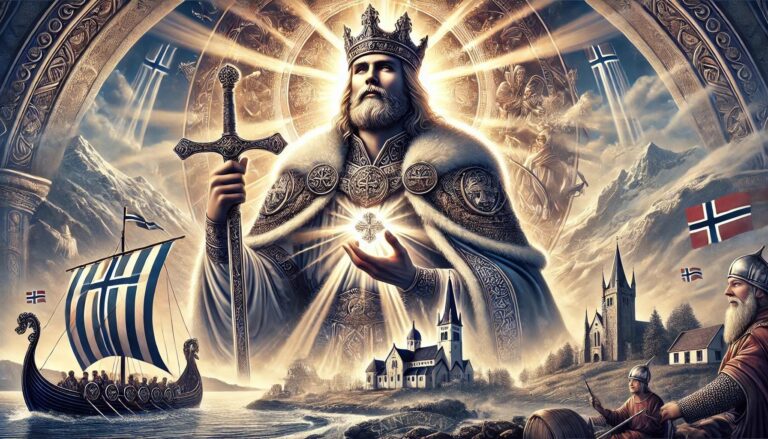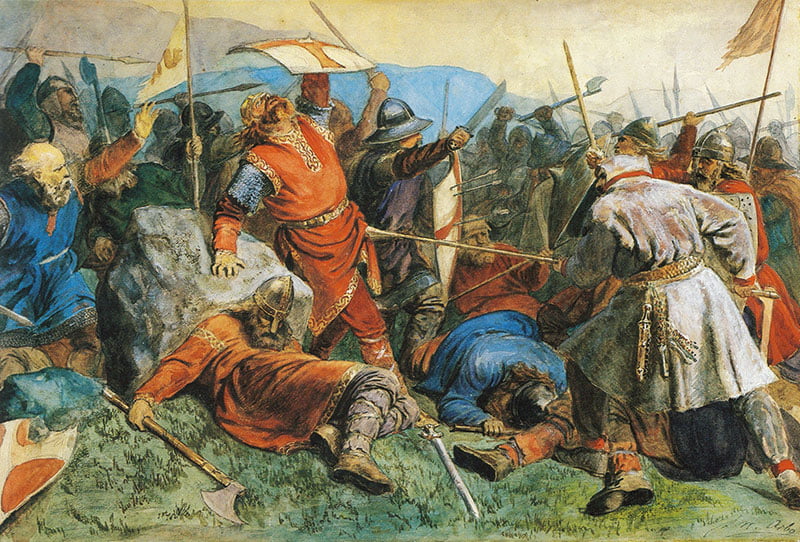Saint Olav, also known as Olaf II Haraldsson, holds a central place in Norwegian history, culture, and religious life. Let’s dive into the fascinating story.
As the eternal king of Norway and its patron saint, Olav's legacy transcends centuries, symbolising the intersection of Viking heritage, Christianisation, and the unification of Norway.

His life, death, and canonization shaped not only the religious landscape of Norway but also its political and cultural identity. This article explores the life of Saint Olav, his significance in Norwegian history, and his enduring legacy.
Early Life and Viking Roots
Olav Haraldsson was born in 995 AD, during a period of great turbulence and transformation in Scandinavia. The region was dominated by Viking chieftains and warrior-kings, who engaged in frequent battles, raids, and explorations.
Olav was the son of Harald Grenske, a petty king in Vestfold, and Åsta Gudbrandsdatter. His early years were steeped in the Viking warrior culture, and by the age of 12, he embarked on his first Viking raid, gaining early experience in the art of war.
Olav's youth was marked by a series of expeditions across Europe, where he fought in England, France, and even as far as Spain. These experiences not only honed his martial skills but also exposed him to the Christian faith, which was beginning to spread across Europe.
The influence of Christianity on Olav during these formative years would later prove pivotal in his reign as king of Norway.
The Path to Kingship
Olav's rise to power was not a straightforward path. Following the death of his father, he returned to Norway in 1015 with the intention of claiming the throne.
Norway at the time was a fragmented collection of petty kingdoms, each ruled by local chieftains with their own allegiances and interests.

Olav, with his formidable reputation as a warrior, managed to gather a significant following and challenged the reigning king, Svein Forkbeard's son, Cnut the Great.
In a series of battles, most notably the Battle of Nesjar in 1016, Olav emerged victorious and was declared the king of Norway. His ascension marked the beginning of a concerted effort to unify the country under a single monarch, an endeavour that would define his reign.
Olav's kingship was characterized by his determination to centralize power, reduce the influence of the local chieftains, and establish a strong, centralized monarchy.
Christianisation of Norway
One of Olav's most enduring legacies is his role in the Christianisation of Norway. Although Christianity had begun to make inroads into the region before his reign, it was Olav who played a crucial role in its widespread adoption.
Upon taking the throne, he embarked on a mission to convert his subjects to Christianity, often employing both persuasion and force.
Olav built churches across the kingdom, established dioceses, and brought in clergy from England and Germany to spread the Christian faith. He also imposed strict laws that required the observance of Christian practices and forbade pagan rituals.
His efforts were met with resistance, particularly from the old pagan aristocracy, who saw Christianity as a threat to their traditional way of life. Nonetheless, Olav persisted, and by the time of his death, Christianity had taken firm root in Norway.
Olav's zeal for Christianity was not solely driven by religious conviction; it was also a political strategy. By aligning himself with the Christian Church, Olav sought to legitimise his rule and strengthen his position against rival claimants to the throne.
The Church, in turn, supported Olav, seeing in him a strong ally who could help consolidate its influence in the region.
The Battle of Stiklestad and Martyrdom
Olav's reign was marked by continuous conflict, both with external enemies and internal dissent.

His efforts to centralize power and enforce Christianity led to widespread discontent among the local chieftains, many of whom had enjoyed considerable autonomy under the previous rulers.
This unrest culminated in a rebellion against Olav, led by a coalition of nobles and supported by the Danish king, Cnut the Great.
The decisive confrontation occurred at the Battle of Stiklestad on July 29, 1030. Olav, leading a relatively small force, faced a much larger army of rebels. Despite his bravery and the loyalty of his men, Olav was defeated and killed in the battle.
His death marked the end of his reign, but it also marked the beginning of his transformation into a saint and a symbol of Norwegian identity.
According to tradition, Olav was buried in a simple grave near the Nidaros River (now the city of Trondheim). Shortly after his death, reports of miracles began to spread, and his grave became a site of pilgrimage.
The Church quickly recognized Olav as a martyr for the Christian faith, and in 1031, he was canonized as a saint by the bishop of Nidaros. His canonization was later confirmed by the Pope, making Olav one of the first canonized saints of the medieval Nordic world.
Saint Olav and Nidaros Cathedral
The site of Olav's burial became the focal point for the construction of Nidaros Cathedral, which would become the most important church in Norway and a major pilgrimage site in Northern Europe.
The cathedral, built in the Gothic style, housed the relics of Saint Olav and served as the spiritual heart of Norway. Pilgrims from across Scandinavia and beyond traveled to Nidaros to pay homage to the saint, seeking his intercession and blessings.

Nidaros Cathedral also became the coronation church for Norwegian kings, further cementing Olav's status as the eternal king of Norway.
The cult of Saint Olav spread rapidly throughout Scandinavia and even into other parts of Europe, with churches dedicated to him being established in Sweden, Denmark, England, and as far away as Constantinople.
Olav's Legacy and the Symbol of Unity
Saint Olav's legacy extends far beyond his role as a Christian king and martyr. He became a symbol of national unity and resistance against foreign domination.
During the Middle Ages, Norway faced numerous challenges, including external threats from Denmark and Sweden, as well as internal strife.
Saint Olav's memory served as a rallying point for the Norwegian people, inspiring them to defend their independence and sovereignty.
The image of Saint Olav as the eternal king and protector of Norway persisted through the centuries, even during periods of political union with Denmark and Sweden.
The saint's feast day, Olsok (Olav's Vigil), celebrated on 29 July, became a national holiday and a time for Norwegians to reaffirm their national identity and Christian faith.
In the modern era, Saint Olav's significance continues to resonate. He is regarded as the patron saint of Norway, and his image is often invoked in connection with national events and celebrations.
The Order of Saint Olav, established by King Oscar I in 1847, is one of Norway's highest honors, awarded to individuals for their outstanding service to the country and humanity.
The Cult of Saint Olav and Popular Culture
The cult of Saint Olav, which began shortly after his death, has endured for nearly a millennium. His life and deeds have been commemorated in various forms of art, literature, and music.
The medieval sagas, particularly “Heimskringla” by Snorri Sturluson, played a crucial role in shaping the popular image of Olav as a heroic and saintly king.
These sagas, which blend historical events with legend, have been instrumental in preserving Olav's legacy and ensuring his place in Norwegian cultural memory.
In addition to the sagas, Saint Olav has been the subject of numerous hymns, poems, and plays. One of the most famous is the play “Saint Olav” by the Norwegian playwright Bjørnstjerne Bjørnson, which premiered in 1859 and became a nationalistic symbol during Norway's struggle for independence from Sweden.
Olav's image has also appeared on coins, stamps, and in public monuments. The statue of Saint Olav in Trondheim, for example, is a prominent landmark and a reminder of the city's historical and religious significance.
In modern times, Olav has been featured in films, television series, and even video games, demonstrating the enduring appeal of his story.
Saint Olav's life and legacy are deeply intertwined with the history and identity of Norway. As a king, he played a pivotal role in unifying the country and establishing Christianity as the dominant religion.
As a martyr and saint, he became a symbol of national unity and resistance against foreign domination. His cult has endured for nearly a thousand years, and his memory continues to inspire Norwegians to this day.
Olav's transformation from a Viking warrior to a Christian king and, ultimately, to a saint, reflects the broader cultural and religious shifts that shaped medieval Scandinavia.
His story is not just a tale of conquest and kingship but also a narrative of spiritual transformation and national identity. In Saint Olav, Norway found not only a ruler but also a protector, a symbol of unity, and an eternal king whose legacy will endure for generations to come.


Hi to you David,
Am I wrong in recalling about ST.Olav that he became his Holy because according to observers, his hair was said to have grown after his death and after that he was deemed to be a saint.